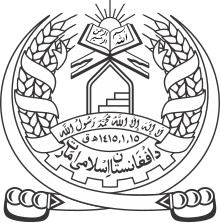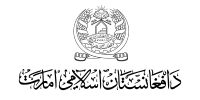
Back الجيش الوطني الأفغاني Arabic আফগান সেনাবাহিনী Bengali/Bangla Exèrcit de l'Afganistan Catalan Afghanistans hær Danish Afghanische Nationalarmee German Ejército Afgano Spanish ارتش امارت اسلامی افغانستان Persian Armée nationale afghane French Tentara Afganistan ID Esercito nazionale dell'Afghanistan Italian
| Islamic National Army | |
|---|---|
| اسلامي ملي اردو | |
 The emblem of the Islamic Emirate of Afghanistan serves as the badge for all branches of the armed forces | |
| Founded | c. 1722 2021 (modern form) |
| Country | Afghanistan |
| Type | Army |
| Role | Land warfare |
| Part of | Afghan Armed Forces |
| Headquarters | Kabul, Afghanistan |
| Commanders | |
| Army Chief | Qari Fasihuddin (from 2021)[1] |
| Insignia | |
| Flag |  |
The Islamic National Army (Pashto: اسلامي ملي اردو, Islāmī Milli Urdu),[2][3][4] also referred to as the Islamic Emirate Army and the Afghan Army, is the land force branch of the Afghan Armed Forces. The roots of an army in Afghanistan can be traced back to the early 18th century when the Hotak dynasty was established in Kandahar followed by Ahmad Shah Durrani's rise to power. It was reorganized in 1880 during Emir Abdur Rahman Khan's reign.[5] Afghanistan remained neutral during the First and Second World Wars. From the 1960s to the early 1990s, the Afghan Army was equipped by the Soviet Union.[6]
After the resignation of President Najibullah in 1992, the army effectively dissolved. In 1996 the Islamic Emirate of Afghanistan (Taliban regime) took power, creating their own army, which lasted until the United States invasion of Afghanistan in October–November 2001.
By 2016, most of Afghanistan came under government control.[7] However over the next few years the government slowly lost territory to the Taliban and eventually collapsed, with Kabul falling to the Taliban in 2021. The majority of training of the ANA was undertaken in the Kabul Military Training Centre. In 2019, the ANA had approximately 180,000 soldiers out of an authorized strength of 195,000.[8] Despite its significant manpower on paper, in reality a significant portion of the Afghan National Army manpower were made up of ghost soldiers.[9]
Following the withdrawal of U.S. and allied troops from Afghanistan in the summer of 2021, in the face of a rapid Taliban offensive, the Afghan National Army largely disintegrated.[10][11] Following the escape of President Ashraf Ghani and the fall of Kabul, remaining ANA soldiers either deserted their posts or surrendered to the Taliban.[12] Some ANA remnants reportedly joined the anti-Taliban National Resistance Front of Afghanistan in the Panjshir Valley (see Republican insurgency in Afghanistan).[13]
- ^ "ملا حسن اخوند وزیر اعظم اور ملاعبدالغنی نائب وزیراعظم ہوں گے، افغانستان میں عبوری حکومت کا اعلان [Mullah Hassan Akhund will be the Prime Minister and Mullah Abdul Ghani will be the Deputy Prime Minister, the announcement of the interim government in Afghanistan]". 7 September 2021."How Are the Taliban Organized?". www.voanews.com. Voice of America. 5 September 2021.
- ^ @MoDAfghanistan2 (17 December 2022). "In the meeting, the officials called the national unity in the ranks of the Islamic Army necessary and assured that they will prepare such an Islamic National Army that will be the protector of Islamic values, national unity, national sovereignty and territorial integrity..." (Tweet). Retrieved 23 June 2023 – via Twitter.
- ^ "Acting Minister of Defense Meets Fresh Recruited Soldiers of Panjshir Province – Islamic Emirate of Afghanistan". 15 October 2022. Retrieved 27 January 2023.
- ^ khan, zahir (10 March 2023). "Deputy Commander of Armed Forces visits borders of the country". Islamic Emirate of Afghanistan, Исламский Эмират Афганистан. Retrieved 18 August 2023.
- ^ Nyrop & Seekins 1986, p. 290–291.
- ^ Giustozzi 2016.
- ^ "Bomb blast hits Afghanistan on security handover day". Deutsche Welle. 19 June 2013. Retrieved 23 June 2013. and "Karzai announces Afghan security handover". Agence France-Presse. Global Post. 18 June 2013. Archived from the original on 22 June 2013. Retrieved 23 June 2013.
- ^ Lead Inspector General 2019, p. 26.
- ^ Engel Rasmussen, Sune. "Afghanistan's 'ghost soldiers': thousands enlisted to fight Taliban don't exist". The Guardian. Retrieved 18 August 2021.Sriram, Akash. "Ghost soldiers emblematic of a problem that has plagued Afghanistan's security for decades — corruption". Deccan Herald. Retrieved 18 August 2021.Shinkman, Paul D. (18 August 2021). "From 300,000 to a Few Hundred: What Happened to Afghanistan's Army". U.S. News & World Report.
- ^ Robertson, Nic (24 June 2021). "Afghanistan is disintegrating fast as Biden's troop withdrawal continues". CNN. Retrieved 15 August 2021.; Chaturvedi, Amit. "Choppers, rifles, humvees: What Taliban captured during Afghanistan blitzkrieg". Hindustan Times. Retrieved 18 August 2021.
- ^ Lieven 2021.
- ^ Sanger, David E.; Cooper, Helene (14 August 2021). "Taliban Sweep in Afghanistan Follows Years of U.S. Miscalculations". The New York Times. ISSN 0362-4331.
- ^ "'Northern Alliance' flag hoisted in Panjshir in first resistance against Taliban". Hindustan Times. 17 August 2021. Retrieved 18 August 2021.